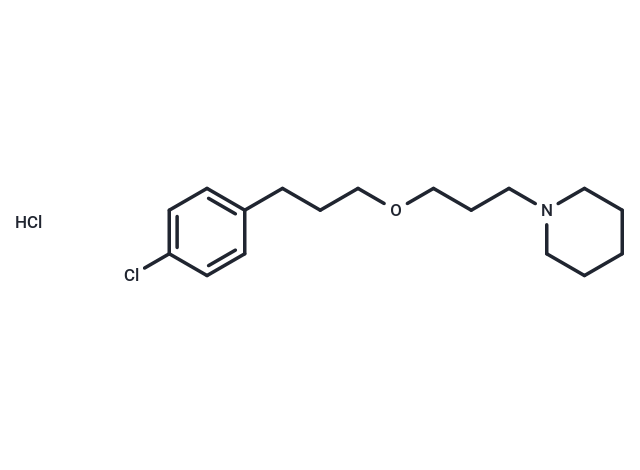Shopping Cart
- Remove All
 Your shopping cart is currently empty
Your shopping cart is currently empty

Pitolisant hydrochloride (Ciproxidine) is a potent and selective inverse agonist of the histamine H3 receptor(Ki : 0.16 nM).

| Pack Size | Price | Availability | Quantity |
|---|---|---|---|
| 5 mg | $43 | In Stock | |
| 10 mg | $68 | In Stock | |
| 25 mg | $126 | In Stock | |
| 50 mg | $207 | In Stock | |
| 100 mg | $328 | In Stock | |
| 200 mg | $492 | In Stock | |
| 500 mg | $787 | In Stock | |
| 1 mL x 10 mM (in DMSO) | $48 | In Stock |
| Description | Pitolisant hydrochloride (Ciproxidine) is a potent and selective inverse agonist of the histamine H3 receptor(Ki : 0.16 nM). |
| Targets&IC50 | H3 receptor:0.16 nM(ki) |
| In vivo | Mice fed with high-fat diet showed more weight gain throughout the 12-week period of inducing obesity. Animals fed with high-fat diet and treated with pitolisant (next 14 days) showed significantly less weight gain than mice from the control group consuming a high-fat diet. From the 10th day of the pitolisant administration, a statistically significant difference in body weight between the groups was observed. Metformin, which served as a positive control, reduced body weight from the ninth day of administration onward[1]. |
| Animal Research | Male CD-1 mice were fed on high-fat diet consisting of 40% fat blend (Labofeed B with 40% lard) for 14 weeks, water and 30% sucrose available ad libitum. Control mice were fed on a standard diet and drank water only. After 12 weeks, mice with obesity induced via their diet were randomly divided into three equal groups that had the same mean body weight and were treated intraperitoneally with test compounds at the following doses: pitolisant 10 mg/kg bw/day or metformin 100 mg/kg bw/day; control group: vehicle =1% Tween 80, 0.35 ml/kg (high-fat/sugar diet + vehicle = obesity control group) once daily in the morning, between 9:00 and 10:00 AM for 14 days. Control mice (control without obesity) were maintained on a standard diet, with intraperitoneal administration of vehicle = 1% Tween 80, 0.35 ml/kg (standard diet + vehicle = control group). Water and sucrose were measured daily, immediately prior to administration of drugs. Animals always had free access to feed, water and sucrose[1]. |
| Alias | Ciproxidine, BF 2649 |
| Molecular Weight | 332.31 |
| Formula | C17H27Cl2NO |
| Cas No. | 903576-44-3 |
| Smiles | Cl.Clc1ccc(CCCOCCCN2CCCCC2)cc1 |
| Relative Density. | no data available |
| Storage | Powder: -20°C for 3 years | In solvent: -80°C for 1 year | Shipping with blue ice. | |||||||||||||||||||||||||||||||||||
| Solubility Information | DMSO: 50 mg/mL (150.46 mM), Sonication is recommended. | |||||||||||||||||||||||||||||||||||
Solution Preparation Table | ||||||||||||||||||||||||||||||||||||
DMSO
| ||||||||||||||||||||||||||||||||||||

Copyright © 2015-2025 TargetMol Chemicals Inc. All Rights Reserved.